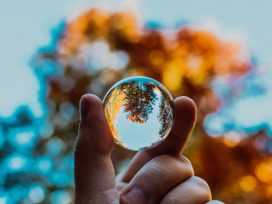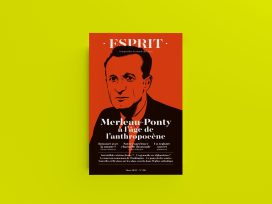Careless mothers, sterile goddesses and ungrateful offspring
Tackling climate change requires more care. Environmentalist slogans demand respect for Mother Earth. But does it make sense to gender a planet? How should nature be perceived? And what does ‘natural’ even mean within an ecofeminist frame?
This writing is addressed to my child-self, who, when I heard – I suppose from my mother – that quote from Simone de Beauvoir, ‘one is not born, but rather becomes, a woman’,1 I misconceived it and understood the opposite. I thought, maybe one day – after menstruation, first-time sex or rather pregnancy? – I would have the honour of becoming a woman, since I didn’t feel able to live up to such a great definition yet.
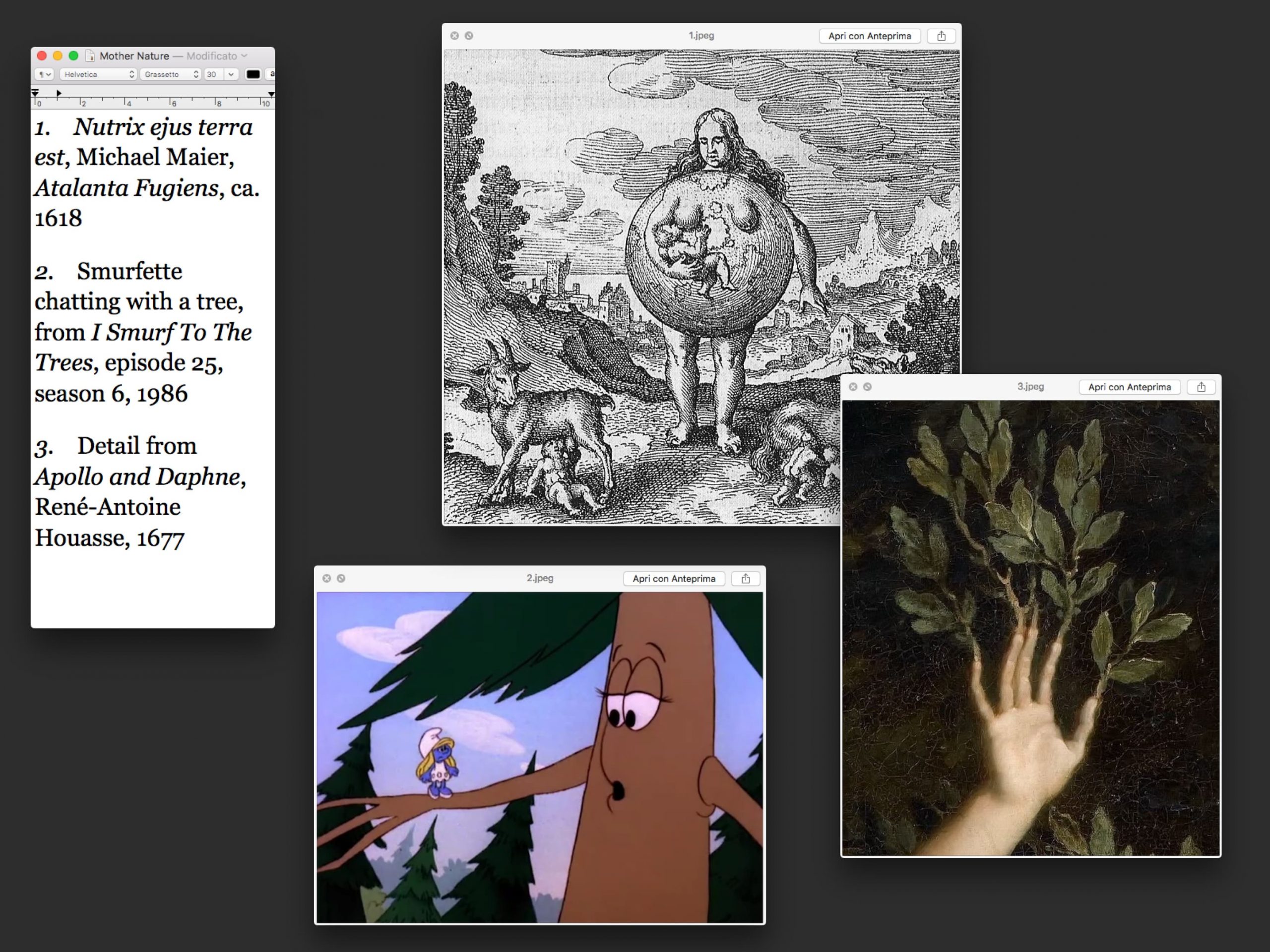
Composite images one, Adele Dipasquale, 2022
Nature is a tricky term. It can refer to the quality of things, to what moves things into existence or to the world as a whole. Read and heard, from political debate to food labelling, it is in constant use: back to nature, 100% natural, natural order, unnatural acts, natural ways of living, wisdom of nature, natural remedies. Despite taking propolis when I get a cough and enjoying organic food, I’m critically suspicious of the term – the concept of Nature is often used to backup moral stand points, as a device for legitimization, claiming and appealing to an external truth as a reference point.
An ecology without Nature
In the first chapter of Facing Gaia, ‘On the instability of the (notion of) nature’, Bruno Latour responds to the contemporary urgency of climate change.2 The Earth’s population is facing a mutated relationship with the world, laden with growing concern and dramatic outcomes. ‘Ecology drives people crazy’, claims Latour.3 This intense reaction can be seen as an appropriate response to the impassivity and the astonishing calm that has characterized the last thirty years, where the hegemonic class did nothing, despite various warnings, to change the economic trend that made the environmental situation so bleak.
‘What could have been just a passing crisis has turned into a profound alteration of the world’, a definitive mutation and not a ‘temporary crisis’, as Latour refuses to call it, which doesn’t allow any going back.4 This compelling encounter takes various forms: headless climate deniers, blind quietists, geo-engineering megalomaniacs with techno-fixing ambitions, hopeless depressives, cynical hermits, incurable optimists. For Latour, we are all ‘pathological’ in one way or another.
However, such reactions are mere evidence of just how deep the shift that the New Climate Regime obliges us to deal with has become.5 The utterance that describes our times as ‘the discovery that humans belong to nature’ could be seen as symptomatic of the extent of human alienation from the world. Timothy Morton refers to this as a ‘quake in the being’.6 It’s the shock realization that nature isn’t a still backdrop for human actions played out on a God-like stage.
Instead, there is no more ‘elsewhere’ because humans are so entangled, immersed and viscously stuck inside ‘the world’. ‘We realize that nonhuman entities exist that are incomparably more vast and powerful than we are, and that our reality is caught in them’.7 Climate change reveals the ‘Intrusion of Gaia’,8 as Isabelle Stengers names it, the definitive irruption of a form of transcendence that we believed transcendable, but which reappears more heavily than ever.9
Stengers uses the figure of Gaia, the living planet, to describe the event that disrupts the fantasy of human exceptionalism. The ancient Greek deity was once feared by all those who knew their livelihood depended on something much greater than themselves. In using the Greek name, and therefore accepting any potentially problematic connotations, Stengers refers specifically to both James Lovelock’s and Lynn Margukis’ ‘Gaia hypothesis’ from the early 1970s.
While Lovelock portrayed the planet as a system with self-regulating capacities, Margulis described it as the product of symbiotic activities and the co-evolution of bacteria. ‘Gaia is not the nurturing mother or fertility doll of the human race. Rather, human beings, in spite of our raging anthropocentrism, are relegated to a tiny and unessential part of the Gaian system,’ wrote Margulis.10
Gaia is an immense and complex system that mostly doesn’t ‘care’ about humans. For Stengers, Gaia is a post-Anthropocene figure that dethrones the narrative of Man as the primary world-making force: ‘deprived of the noble qualities that would allow it to be invoked as an arbiter, guarantor, or resource’, Gaia is ‘a ticklish assemblage of forces that are indifferent to our reasons and our projects’.11 This Gaia cannot be used to support any opinion, it’s not something to invoke or to appeal to.
Environmentalism, and its operation of self-critique – namely ecocriticism – are cultural and political responses to this moment of rupture. According to Latour, the difficulty lies in the very expression ‘relation to the world’, which presupposes two domains: that of Nature and that of Culture. But since neither of the two could exist without the other, ‘we are not dealing with domains but rather with one and the same concept’: Nature/Culture.12
‘If ecology sets off panic reactions, we now understand why: because it obliges us to experience the full force of the instability of this concept, when it is interpreted as the impossible opposition between two domains that are presumed actually to exist in the real world’.13 All attempts are done to stabilize the concept of Nature and keep it far away from Culture.
Latour asks, ‘in the name of what do you dare decide which behavioural norms are “natural” and which are “against nature”?’ … ‘Any effort to stabilize an ethical judgment by the invocation of nature will appear as the scarcely concealed disguise of an ideology’.14 Nature is unstable, just like morality, legality or respectability.
However, the invocation to naturality still has a very strong normative and prescriptive charge. The underlying assumption is that the laws of nature must be respected and will impose themselves on whatever one might do or think. ‘We are at the point where the moral connotation of the notion of “nature” has been so clearly overturned that the first reflex of every critical tradition consists in fighting naturalization’.15 Denaturalization has thus become a common analytical device in feminist, black, decolonial and critical studies.
Invocating the ‘natural world’ is ambiguous, because it is based on the assumption that Nature doesn’t have any moral lesson to impart, since it is ‘just there’, ‘a formidable prescriptive charge conveyed by what is not supposed to possess any prescriptive dimension’.16 The ‘craziness’ described by Latour is a reaction to the forced acknowledgment of Nature’s instability. Ecology is not the irruption of Nature in daily life but the end of Nature as a concept that allowed us to sum up our relationship with the world.
Nature is presented both as the alleged non-moral and unchallengeable arbiter, and as the supreme moral value. The Supreme Court of Nature, used as a transcendental unit of measure, dictates, with the force of law, the norm in relation to which deviation is measured.17 Therefore, certain actions are considered ‘according to nature’ or against it.
This strategic mobilization of Nature informs various discourses in contemporary debate where ‘natural’ is used in place of ‘normal’ and the ‘norm’ is replaced with ‘nature’, shifting discourse from an ethical to a metaphysical level. In other words, this mobilization refers to phenomena and events as undeniable and universal instead of particular, possible yet also not, accidental products of historical, political and cultural systems.
Women without Nature
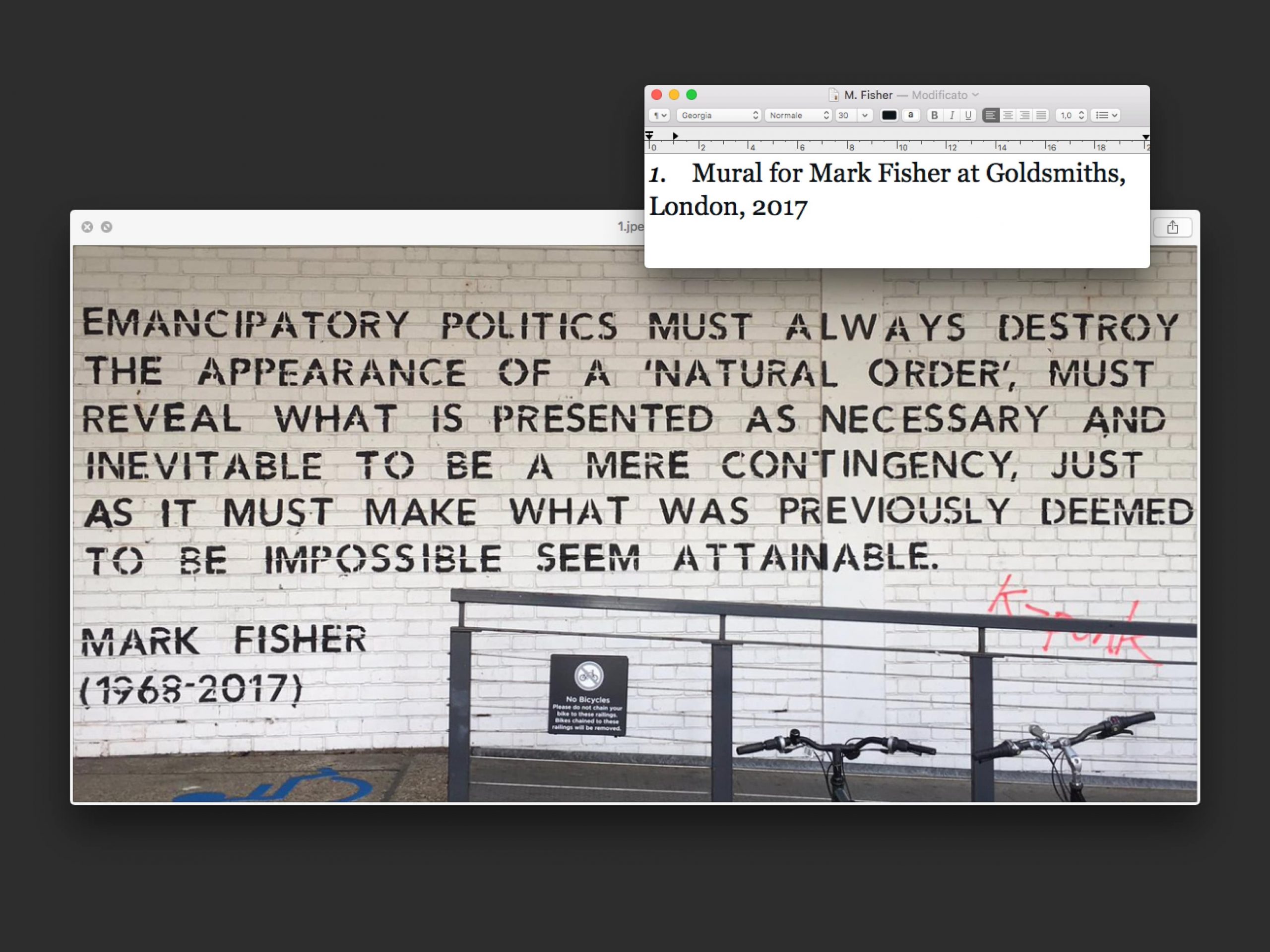
Composite images two, Adele Dipasquale, 2022
The use of ‘natural’ as universal has had a pivotal position in the gender debate. In the western heteropatriarchal regime, nothing has been so naturalized as the sexual order – what a man is, what a woman is, and which sexualities and subjectivities conform to this statute. Gender has been presented as what just is. Historically, feminist, queer, trans*, black and postcolonial practices, have done much to reveal this system. Nevertheless, the use of Nature as a legitimizing device in ethical debates never becomes outdated. Backlashes from the reactionary and conservative fringe continue to pop up periodically with all their violent and fascistic charge.18
The European Agenda, a platform that unifies various anti-feminist and anti-abortion movements around Europe, calls for ‘Restoring the Natural Order’, which veils the idea that men’s predominance over women is ‘natural’ and given.19 Allan Carlson, the founder of the World Congress of Family, declares that ‘family is an institution that pre-exists every nation or state’.20 According to this mindset, the heteronormative institution precedes law and ethics and therefore can’t be dismantled.
Pope Francis also calls for a ‘natural order’ and ‘sound principles’ against widespread current ‘relativism’.21 The Vatican tries to find shelter and justification in science, appealing to today’s new, indisputable metaphysics, using allegedly set biological markers to prove that sexual order is unquestionable: hormones, genetics, evolutionary differences, brain conformation.
The point to defend is always the same: men and women are two distinct, natural and complementary groups, and whoever doesn’t fit inside this grid lives a deceitful, misled life. Besides the traditional rhetoric, catholic morality is fighting to survive, expressing its last compulsory hiccups in shifting rhetoric from woman’s subordination to ‘natural complementarity’ and ‘equality in differences’.
But the situation doesn’t change. This new ‘theology of woman’, which emphasizes woman’s alleged peculiarities, alongside the bugbear invention of ‘Gender Ideology’, which fears a monstrous, chaotic society, all promiscuous and sexualized, are two parallel strategies to re-essentialize the discourse of sexual order.22
These cosmetic strategies used by the Vatican, which highlight ‘the specificity of feminine genius’, explain the otherwise implausible new alliances that are arising in Europe and the US between religious and anti-abortionist associations and new ‘feminists of difference’ and TERF movements.23 Even among self-declared feminists, the myth of Nature – alongside the myth of Woman, its historical companion – hides in the most surprising places.
I’m in the middle of a forest in the mountains on the Greek-Albanian border in a ‘gathering’ where thousands of people from all over the world are meeting to temporarily live in an ecological community without electricity, money, running water, hierarchical institutions, relying on the principles of peace, sharing, freedom and environmental care. I’m at a gender separatist session to regenerate my ‘female energy’. Today is particularly fertile for the influence of the full moon that brings out ‘feminine creativity and genius’. I feel uncomfortable. Maybe it’s because I’m not a Woman. Hopefully, one day I will be. (Greece, August 2013)
Nothing has been as naturalized in western history as gender. ‘She’ has a biologically female body – a vagina, breasts and a uterus – therefore she is a Woman, doing lady’s stuff and women’s works, thinking as a woman, producing female art, manifesting her womanhood in everything she does. This is her ‘nature’.
But what is a Woman? Surely, it would be better to ask, ‘who is this very woman?’ Or what does being a Woman mean and what has it to do with Nature? Here Nature – and Woman’s Nature – is a concept that depends on an operation of ‘normalization’ produced by those who decide what the ‘norm’ is.
A critique of naturality has always been central in feminist debate. Women, non-cisnormative and non-heteronormative subjectivities, and racialized people know the dangerous outcomes of this discourse. ‘Women’s nature is to nurture’ has always been the imperative. ‘A hundred definitions, a thousand contradictions’ were given for the nature of womanhood, ‘for which no one of course expected a woman to answer,’ writes Adriana Cavarero.24
Woman was the opposite pole, always defined by and through her negation: in Simone de Beauvoir’s words, ‘he is the subject, he is the Absolute – she is the Other’.25 And this Other is deceptive, irrational, weak, passive, always defined by what it allegedly lacks in comparison to the universal Man. Described from the outside, women were depicted, in the best case scenario, as governed by their hormones and menstrual cycles, connected to viscerality on account of their reproductive and gestational bodily qualities – a gender embedded in corporality and nature at best, in sin and flesh at worst.
This is the ambiguous tangle of power and fragility that men saw in the other sex and therefore described as an opposite mirror to build his own self-confidence and dominance through her subjugation, negation and unrecognized labour.
A very queer, composite being thus emerges. Imaginatively she is of the highest importance; practically she is completely insignificant. She pervades poetry from cover to cover; she is all but absent from history. She dominates the lives of kings and conquerors in fiction; in fact she was the slave of any boy whose parents forced a ring upon her finger. Some of the most inspired words, some of the most profound thoughts in literature fall from her lips; in real life she could hardly read, could scarcely spell, and was the property of her husband.26
This is the odd being that emerges from Virginia Woolf’s analysis of the myth of Woman. On the one hand, She is subjected to absolute fictional mystification, on the other total historical insignificance within the strongholds of power, politics and cultural production: two sides of the same system, both negating any individual subjectivity.
Teresa de Lauretis explains the paradoxical process of self non-recognition in this prescriptive and manufactured identity:
In the early 1970s, in its first attempt of self-definition, feminism posed the question: Who or what is a woman? Who or what am I? And, as it posed those questions, feminism – a social movement of and for women – discovered the nonbeing of woman: the paradox of a being that is at once captive and absent in discourse, constantly spoken of but of itself inaudible or inexpressible, displayed as spectacle and still unrepresented or unrepresentable, invisible yet constituted as the object and the guarantee of vision; a being whose existence and specificity are simultaneously asserted and denied, negated and controlled.27
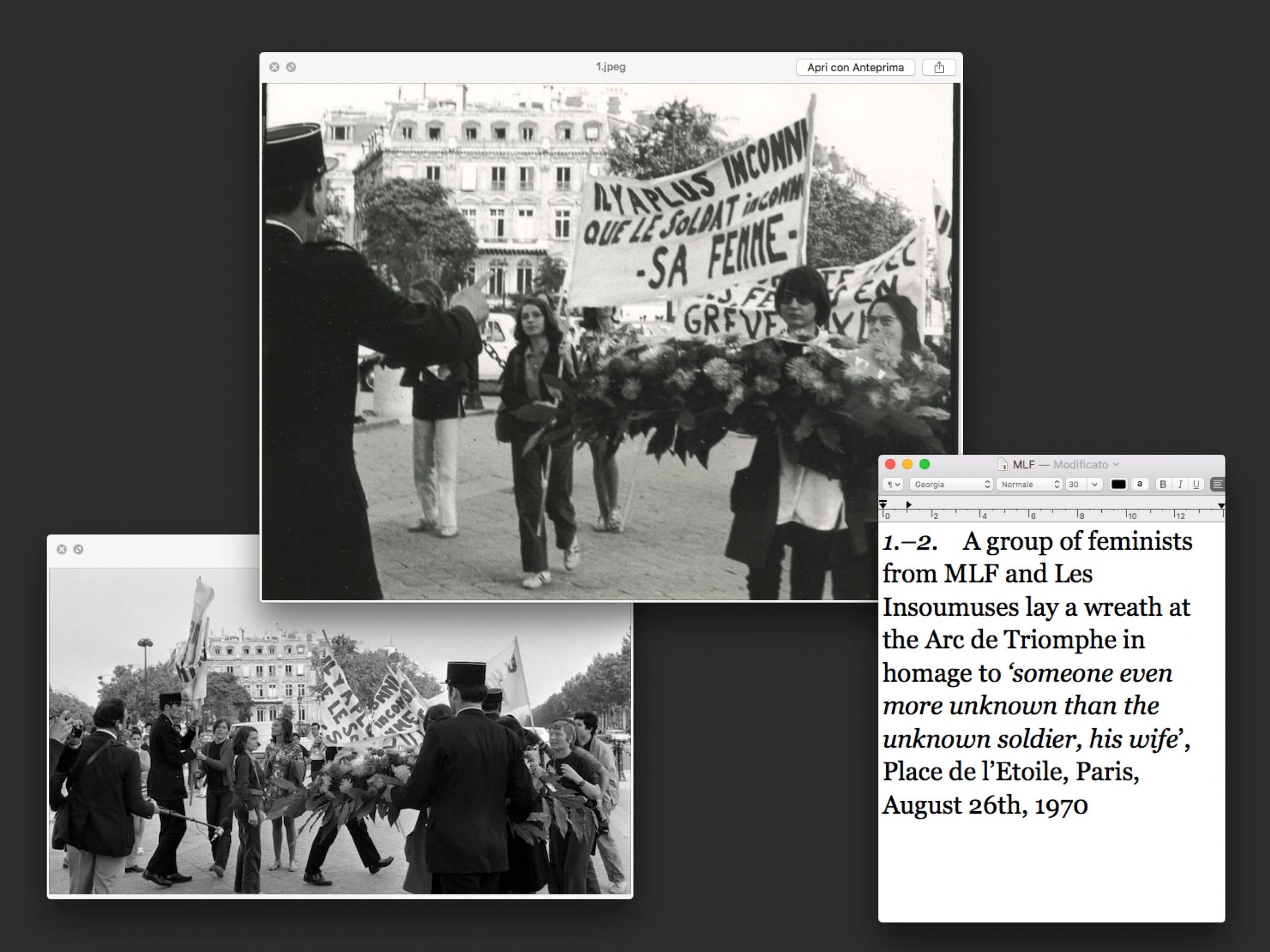
Composite images three, Adele Dipasquale, 2022
‘This sex which is not one’, to use Luce Irigaray’s formula, is just a theoretical, discursive syntagma that doesn’t exist in its abstraction nor in its material manifestations.28 What remains are only the peculiarities of the life of the very women and, maybe, the similar, but mostly very different kinds of oppression that they experience in their individual lives.
Therefore, as Monique Wittig suggests, we have to ‘dissociate “women” (the class within which we fight) and “woman”, the myth. For “woman” does not exist for us: it is only an imaginary formation, while “women” is the actual product of a social relationship’.29 The binary economy that defines gender produces only very prescriptive, narrow and partial identities in which the material process of being and becoming a subject cannot find space.
The sexual order, with its gender binarism and polarization between masculinity and femininity, continues to operate, sneaking around from Catholic propaganda to New Age movements. It operates in a two-pronged manner: through the feminization of Nature and the naturalization of Woman.
A planet without Gender
I’m at a Fridays for Future demonstration, walking beside me there’s a woman holding a placard on which is written ‘Respect your mother’, a blue globe is painted underneath. Mother-Earth: ‘She’ is the one that always gives, nurturing and life conceiving, completely open and penetrable. Despite any pain inflicted, her love is unconditional. (Netherlands, September 2019)
Planet Earth has been deemed feminine. Nature and Woman as abstract and very regressive figures overlap in its features. But do we really need to attribute a gender to the planet? The image of the planet as a compassionate woman has been abused in a lot of deep ecology movements, where Lovelock’s hypothesis of the living planet has perhaps been taken a step too far. The placard at the FFF march is the debris of this narrative.
Isabelle Stengers contrasts the image of Nature as a benevolent mother, who pardons everything and waits to be protected, with the figure of Gaia. On the contrary, ‘Gaia is ticklish and that is why she must be named as a being. We are no longer dealing (only) with a wild and threatening nature, nor with a fragile nature to be protected, nor a nature to be mercilessly exploited. The case is new. Gaia, she who intrudes, asks nothing of us, not even a response to the question she imposes.’30 Nature is neither fragile nor intentionally threatening, neither a benign, maternal organism nor a vindictive entity. It has no goal and no intentionality. It exists irrespective of human presence.
The feminization of the environment isn’t new. Ecofeminism has highlighted how the same mechanisms of male western capitalism are employed in the (ab)use of land and resources, both human and non-human. The exploitation and degradation of environmental systems, of landscapes and more-than-human creatures, are products of the very same domination system that oppresses and exploits women.
Capitalistic economy looks on the Other as commodified objects, as a means to infinite accumulation and ‘growth’. As Rosi Braidotti states, ‘women were classified alongside natives, animals and others as referents of a generative force that was reduced to a mere biological function and deprived of political and ethical relevance’.31
Ecofeminism has analysed the links between modes of enclosing the productivity of nature and the exploitation of gendered and racialized subjects in the process of capitalist accumulation, the plundering of resources together with sexist and racist forms of dispossession. Therefore, according to ecofeminism, the destinies of women and the planet are intertwined, both in their oppression and possible liberation.
Regarding the feminization of Nature and her Goddesses, Déborah Danowski and Eduardo Viveiros de Castro pinpoint Pachamama,32 the ‘Mother of World-Time’, a deity, who, at least originally, had no attributes that could be considered maternal. Pachamama, once subjugated, was progressively assimilated with the Virgin Mary as icon and finally adopted by New Age movements as benevolent Mother Nature. The only benefit to Pachamama, say the authors, is at least – in contrast with Gaia, Donna Haraway’s Chthulucene,33 apocalypses, catastrophe and so on – she doesn’t speak Greek.
Even if it would be unfair to reduce ecofeminism to a polarizing paradigm that opposes the nurturing qualities associated with Woman/Nature against masculine technosciences, certain ecofeminist formulations seems to be counterproductive for both feminist and environmental causes.
Firstly, the proposition that women, after being confined for centuries to the realm of caring and nurturing, excluded until recently from power management, cultural production and institutions, will carry the burden of environmental devastation isn’t in accordance with the principles of climate justice, which ask for accountability and reparation from those who cause damage, so that the ones who are least responsible don’t have to suffer climate change’s gravest consequences.
Secondly, the idea that women are especially close to nature for biological reasons lies latent in this narrative. Some forms of ecofeminism seem forgetful of the second wave feminist slogan ‘biology is not destiny’ and return to an essentializing idea of Nature and Gender. Can the fact that Woman has a uterus really mean that she lives more in harmony with the environment? Not all women have uteruses and not all uterus-carriers are women. Moreover, I think we have to be very clear in specifying which women we are talking about: indigenous women, who actively fight against neocolonial and capitalist land exploitation, or new ‘CEO feminist’, white, female leaders?
Furthermore, the mystification of the moon and menstrual cycles, the focus on the gestational and reproductive body, risk closing female bodies once again into a strict definition of womanhood – which is accidentally very similar to that historically provided by Man. Selecting the most positive features among those provided by Man – such as care, the capacity to give life, distance from war, violence and power – is not a satisfying solution. Lastly, gendering the planet, is a form of anthropomorphization, which applies the very same gaze that ecocritical thought is trying to subvert.
The best intuition that ecofeminism has provided instead is the idea of solidarity, allyship and intersectionality between struggles. Maybe, women, having always occupied that ‘other’ position, could come close to more-than-human others or other otherness, even if they don’t share the same kind of oppression. Regarding the relationship between the mutual feminization of Nature and the naturalization of Women, Astrida Neimanis writes:
We find ourselves tangled in intricate choreographies of bodies and flows of all kinds – not only human bodies but also other animal, vegetable, geophysical, meteorological and technological ones; not only watery flows but also flows of power, culture, politics and economics. So if projects that move us to think about animal ethics, or environmental degradation, or neocolonialist capitalist incursions are still “feminist,” it is not because such questions are analogous to sexual oppression; it is rather because a feminist exploration of the inextricable materiality/semioticity that circulates through all of these bodies pushes at the borders of feminism, and expands it.34
What can guide us in this debate is the transformative and generative power that feminisms have had historically in subverting a social order that was always imagined as given and immutable. I refer to it as a practice whose subject is the radical transformation of society as a whole. Feminisms, here, are constant practices of undoing and transitioning, unveiling repressive structures from the outside and, at the same time, unravelling them from the inside, since the self is also a product of the very same mechanism – deconstruction, undoing, becoming, questioning the very idea of power over generativity and change.
Natures, women: A positive indeterminacy
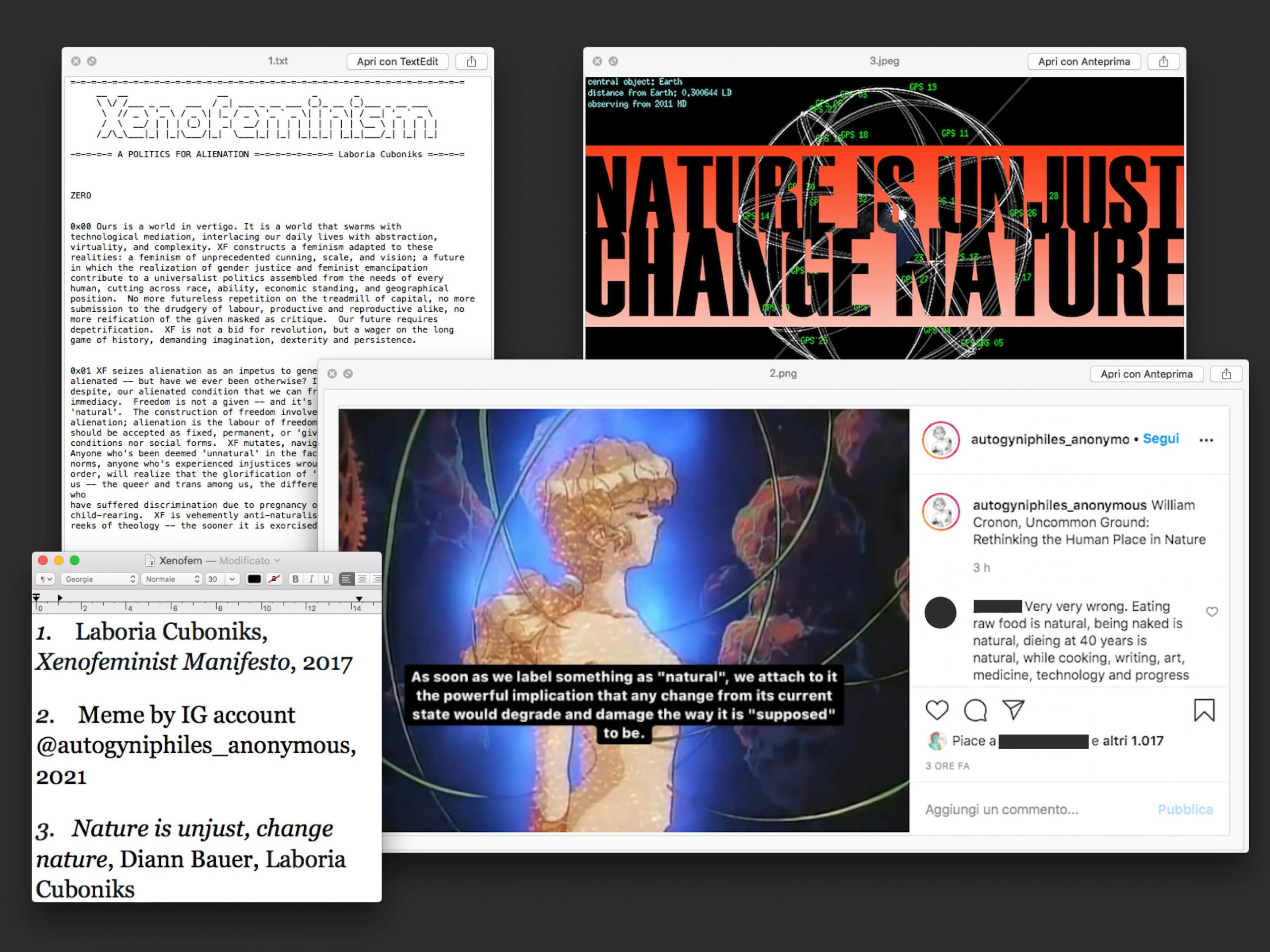
Composite images four, Adele Dipasquale, 2022
Nowadays, everything, from evolutionary biology to endocrinology, passing through the ethology of animal species is wheeled out to support or debunk stereotypes on sexuality and gender. The scientific basis of these claims is often shaky. But even if not, there’s no reason to accept injustice because it’s considered ‘natural’ or ‘scientifically proven’.
Many LGBTQIA+ organizations explicitly dispute any suggestion that being trans* or homosexual might be considered a choice, often using the narrative of ‘being born in the wrong body’ or ‘being born this way’. Some offer comparisons with the sexual behaviour of certain animal species, saying that, for example, same-sex intercourse happens in animals as well – a claim that is stunningly obvious. All these positions can be considered practices of ‘strategic naturalism’, a way to legitimize one’s own identity presenting it as ‘natural’.
But if we bring the discussion back to the level of ‘naturality’, we lower the tone of discourse to that of our opponents and we are never going to make any substantial changes this way. Wouldn’t it be better to create a counter-narrative that doesn’t cling to ‘naturality’ to defend unalienable rights and acts of self-determination?
Regarding the strategic use of nature, Helen Hester, who has a firm anti-naturalist viewpoint as a Xenofeminist (XF),35 says:
Whether through a doctor or psychologist’s diagnosis, or through personal self-affirmation in the form of a social utterance, we have come to believe that there is some internal truth to gender that we must divine. Such concessions are understandable given the perpetually embattled condition of queer and trans* communities. Indeed, inevitabilizing one’s own existence is a pretty shrewd move when labouring to ensure one’s basic survival. However, XF would question the long-term utility of positioning these approaches as the primary form of trans* politics, given that they mark a retreat from one of the most radical and emancipatory tendencies of transfeminism: its capacity to operate as an arduous assertion of freedom against an order that seemed immutable.36
The discourse of ‘strategic naturalism’ – however powerful it could be to fight for the existence, always threatened, of certain subjectivities – seems to allude to a concept of identity as a hidden truth inside us, possible to find through a process of self-exploration. I’m suspicious of the alleged presence of a final truth inside the self, an essence of the being. I would rather encourage a counter-narration from the perspective of continuous redefinitions and choices.
In this fight against the immutable, I prefer a politics rooted down in the mud, calling for a shapeshifter creature impossible to grasp by a monolithic concept of identity, for a subject never defined once and for all, politically and performatively form, collectively reproduced, always informed by relations and negotiations with the outside. In order to be faithful to this non-principle and non-theory, I would rather worship a sterile goddess than a natural one. A goddess hormonologically intoxicated, a polluted deity that has to deal with the impurity and trash someone left there before.
‘I would rather be a cyborg than a goddess’, Haraway would say.37 The monstrous has always defined the limits in the western imagination between human and non-human, masculine and feminine. ‘A cyborg body is not innocent; it was not born in a garden; it does not seek unitary identity and so generate antagonistic dualisms without end (or until the world ends)’.38 In these non-unitarian and centrifugal movements, this liminal figure challenges the phallogocentric discourse of a discrete, self-sufficient, independent and pure Man. As Ada Smailbegovic says:
Feminist thinkers, in particular, have drawn on the traditions of natural history that have struggled to convey the sense of nature as changing, as well as on the philosophical traditions that have intertwined with them, to develop a non-essentialist understanding of nature and the biological body as a site of indeterminacy.39
From my perspective, we are all in transition, even if we don’t change our names or take hormones, until the day of our passing and maybe even after. I look at the biological body as a place of non-determinacy, a site of resistance, experimentation, negotiation and contradictions. This body is never stable: it’s constructed yet also always elusive to control; subjugated to institution, power and will, yet, at the same time, inevitably fleeing out.
‘The body has been for women in capitalist society what the factory has been for male waged workers: the primary ground of their exploitation and resistance’.40 As Silvia Federici remembers, bodies have been not only places of negations but also the space for self-affirmation. Never self-produced, but shaped by time, relations, feelings, more-than-human creatures, illness, decay. Something to come to terms with, to change and to embrace.
In its monstruous shapeshifting, the body cannot be separate, self-sufficient and self-defined. As Elvia Wilk posits, ‘every body is permeable and porous, host to and hosted by trillions of other life-forms. The body is a transitional ecosystem; it can’t survive in a vacuum’.41 We are symbiotically and vulnerably entangled with a more-than-human world.
This monstrosity is just as full of wonder and terror as always. Symbiosis, the co-making of living things, is essential to life on earth – from corals and lichens to the human microbiome inside our guts. Its vulnerability lies in everything being tied to others in rapidly shifting worlds, systems share their lively or deadly futures and sometimes disrupted relations lead not to riotous reproduction but to decline and death, as is happening in our troubled times.42
This sense of unfamiliarity and uncanniness towards nature and toward ourselves is maybe the only point where we can breathe fresh air in the demanding pursuit of narrating another mythology that will allow us to deal with the indeterminate conditions of environmental damage.
This text is an edited version of the first chapter of ‘All the stories we might tell’, MA Artistic Research thesis, Royal Academy of Arts KABK, Den Haag. It was awarded the KABK Thesis Master Award in 2020 and then published by Robida, issue 7, The Forest, in 2021.
Simone de Beauvoir, The Second Sex, Vintage Books, 1949, p. 273.
Bruno Latour, Facing Gaia. Eight Lectures on the New Climatic Regime, Polity Press, 2017.
ibid., p. 13.
ibid., p. 9.
Latour prefers to use the term ‘New Climate Regime’ rather than ‘Anthropocene’.
Timothy Morton, Hyperobjects, Philosophy and Ecology after the End of the World, University of Minnesota Press, 2013.
ibid., p. 130.
Isabelle Stengers, In Catastrophic Times. Resisting the Coming Barbarism, Open Humanities Press, 2015.
Déborah Danowski and Eduardo Viveiros de Castro, The Ends of the World, Polity Press, 2017. p. 14.
Miriam Tola, Composing with Gaia: Isabelle Stengers and the Feminist Politics of the Earth, PhaenEx 11, No. 1, spring/summer 2016, p. 3.
Isabelle Stengers, In Catastrophic Times. Resisting the Coming Barbarism, Open Humanities Press, 2015, p. 47.
Latour refers to ‘Nature/Culture’, Donna Haraway to ‘naturecultures’. Both recognize their inseparability without any priority, causality or foundation. Natures and cultures intertwine with one another, becoming unrecognizable. See: Bruno Latour, Facing Gaia. Eight Lectures on the New Climatic Regime, Polity Press, 2017, p. 15.
Bruno Latour, Facing Gaia. Eight Lectures on the New Climatic Regime, Polity Press, 2017, p. 19.
ibid., p. 21.
ibid.
ibid., p. 23.
In his analysis Morton claims for an ecology without Nature: ‘In the name of ecology itself: down with nature!’ Nature, as a prescriptive old transcendental unified category, is a product of Romanticism, where the bourgeoisie had to replace the authority of God, bounded with royalty and aristocracy, with a new one. Ultimately, there is not such thing as Nature. Timothy Morton, Ecology without nature. Harvard University Press, 2009, p. 14.
Looking at Italian politics alone, there are plenty of examples of recent movements and events organized by Christian, anti-abortionist, ‘pro-family’ groups: ‘Family Days’ (2007, 2015, 2016), ‘Sentinelle in piedi’ (2015), ‘World Families Congress XXIII in Verona’ (2019).
European Parliament Forum for Sexual and Reproductive Rights. “Restoring the Natural Order”: The religious extremists’ vision to mobilize European societies against human rights on sexuality and reproduction. 20 April 2018, https://www.epfweb.org/node/690/ [last accessed 4 May 2019].
Carl C. Carlsson, “What’s wrong with the United Nation's definition of the family”. 1 July 1994. https://www.pop.org/whats-wrong-with-the-united-nations-definition-of-the-family/. [last accessed 4 May 2019].
The battle against ‘the dictatorship of cultural relativism’ was started by Pope Benedict XVI but is continued by Pope Francis today.
Sara Garbagnoli, “Il genere, la denaturalizzazione dell’ordine sessuale e la reazione del Vaticano”, 4 August 2016, https://www.intersexioni.it/il-genere-la-denaturalizzazione-dellordine-sessuale-e-la-reazione-del-vaticano/ [last accessed 2 October 2019].
TERF, Trans-exclusionary feminists, a minoritarian fringe inside the feminist movements, believe in the biological roots of womanhood and rejects trans women. Between TERF and Transfeminism/Intersectional Feminism there is an open fight.
Adriana Cavarero, Relating Narratives: Storytelling and Selfhood, Routledge, 2001, p. 53.
Simone de Beauvoir, The Second Sex, Vintage Books, 1949, p. 16.
Virginia Woolf, A room of one’s own, Feedbooks, 1929, p. 49.
Teresa de Lauretis, Eccentric Subjects: feminist theory and historical consciousness, Feminist Studies 16, 1990, p. 115.
This sex which is not one explicitly refers to woman’s sexuality and how it has been described for what it allegedly lacks (e.g., Freudian penis envy). The woman was conceived as an imperfect and defective man (e.g., the clitoris was seen as a mini penis). Irigaray wants to disrupt this unitarian discourse called phallogocentrism. ‘The mystery that woman represents in a culture claiming to count everything, to number everything by units, to inventory everything as individualities. She is neither one nor two.’ … ‘Further, she has no “proper” name. And her sexual organ, which is not one organ, is counted as none’. For the phallocentric discourse, the female sexual organ is seen only as a non-penis, therefore as a ‘nothing’. Luce Irigaray, This sex which is not one, Cornell University Press, 1985, p. 26.
Wittig is a gender abolitionist. She calls for the destruction of the class of woman and the idea of woman as a natural group. This has to be pursued through the destruction of the heterosexual regime and the destruction of the doctrine of difference that is used to justify it. Because what makes a woman is a specific social relation of servitude with a man, a lesbian is not a woman. For Wittig, being lesbian is a method of fugitivity, a concept that goes beyond the categories of sex. Monique Wittig, One is not born a woman. In: The Straight Mind and Other Essays, Beacon Press, 1981, p. 20.
Isabelle Stengers, In Catastrophic Times. Resisting the Coming Barbarism, Open Humanities Press, 2015, p. 46.
Miriam Tola, Composing with Gaia: Isabelle Stengers and the Feminist Politics of the Earth. PhaenEx 11, No. 1, spring/summer 2016, p. 10.
Déborah Danowski and Eduardo Viveiros de Castro, The Ends of the World, Polity Press, 2017, p. 112.
Cthulucene is the name that Donna Haraway gives to our contemporary age, in opposition to the term Anthropocene which supports the idea of human exceptionalism once again. Chtulucene takes its name from the spider Pimoa cthulhu and ‘from denizens of the depths, from the abyssal and elemental entities, called chthonic’. It’s a tentacular figure that dethrones the Anthropos and tells another mythology, a big-enough story, that enables us to stay with the trouble and to be able to practice response-ability, to give responses. See: Donna Haraway, Staying with the Trouble: Making Kin in the Chthulucene. University Press, 2016.
Astrida Neimanis, Hydrofeminism: or, on becoming a body of water. in Undutiful Daughters. Henriette Gunkel, Chrysanthi Nigianni and Fanny Söderbäck (ed.s), Palgrave Macmillan, 2012, p. 96.
Anti-naturalism is one of the main points of the Xenofeminist Manifesto: ‘In the name of feminism, “Nature” shall no longer be a refuge of injustice, or a basis for any political justification whatsoever! If nature is unjust, change nature!’ Laboria Cuboniks, Manifesto on Xenofeminism: A Politics for Alienation, September 2018, https://www.laboriacuboniks.net/ [last accessed 5 May 2019].
Helen Hester, Xenofeminism. Polity Press, 2018, pp. 26-28.
Donna Haraway, A Cyborg Manifesto: Science, Technology, and Socialist-Feminism in the Late Twentieth Century. in Simians, Cyborgs and Women : The Reinvention of Nature, Free Association Book, 1991, p. 181.
ibid., p. 180.
Ada Smailbegovic, Cloud Writing: Describing Soft Architectures of Change in the Anthropocene. in Art in the Anthropocene, Open Humanity Press, 2015, pp. 98–99.
Silvia Federici, Caliban and the Witch: Women, the Body and Primitive Accumulation, Autonomedia, 2004.
Elvia Wilk, The Word Made Fresh: Mystical Encounter and the New Weird Divine, E-flux Journal #92, June 2018, p. 13.
Anna Tsing et al., Arts of Living in a Damaged Planet, University of Minnesota Press, 2017, pp. M1–M11.
Published 3 February 2022
Original in English
First published by Robida 2020/21
© Adele Dipasquale / Robida / Eurozine
PDF/PRINTIn collaboration with
In focal points
Newsletter
Subscribe to know what’s worth thinking about.
Related Articles

The ceasefire between Hamas and Israel has brought a sigh of relief to the international community – not least because we love to avoid discussing, even thinking about this conflict. Why is that? In this Standard Time episode we talk about anti-muslim racism and how to understand what’s happened in Gaza.
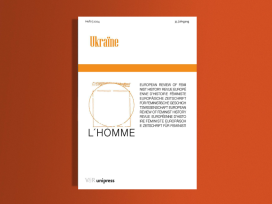
Hidden groundbreakers
L'Homme 1/2024
Localized political shifts have shaped Ukrainian women’s rights over the centuries: the Russian Empire once afforded property rights for aristocratic women in the south; socially active daughters of Greek-Catholic priests founded Galician societies under Habsburg rule; and forced migrants today forge new academic paths.

